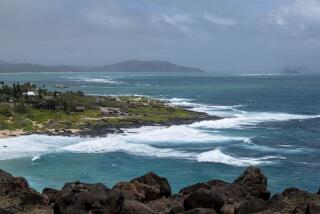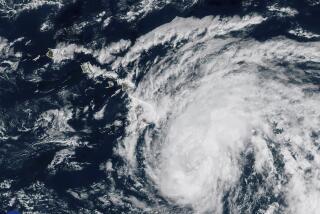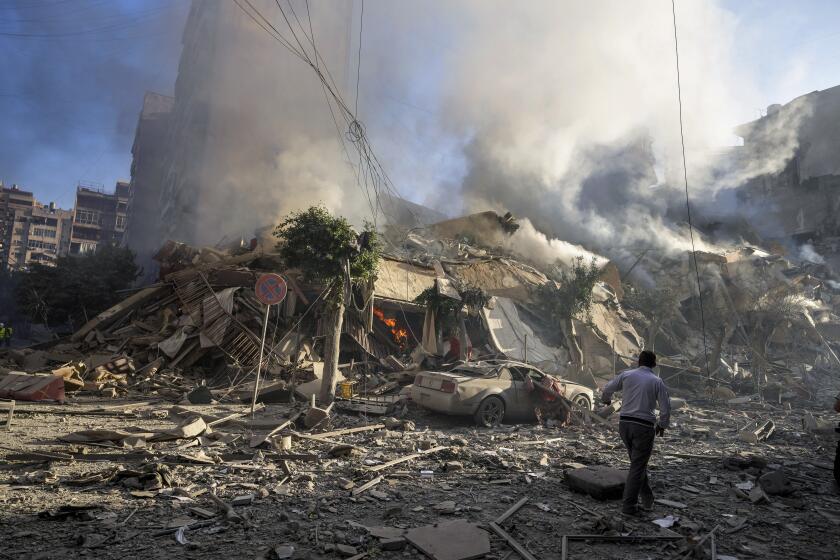Relief as high waves spare Hawaii
Reporting from Seattle — It started with a phone call from a neighbor at 4:30 a.m., jarring Maureen Goto awake at her seaside bed-and-breakfast in Hilo.
“A tsunami’s coming,” the neighbor said. A little more than an hour later, civil defense sirens sounded in coastal areas across the state, triggering the evacuation of as many as 100,000 people and a tense day of waiting for a possible disaster.
“They said, ‘You have to go inland, and up,’ ” said Goto, whose 1930s-era mansion in Hilo, on the island of Hawaii, had already withstood tsunamis that twice devastated the town.
“It was spooky, especially when you’re just listening to the radio, and they say the water’s receding out of the bay, and the next thing you know it’s coming back up over the bridge,” she said. “You’re just sitting there, not knowing if the big one is coming with the next few waves.”
The first Pacific-wide tsunami advisory since 1964, triggered by an 8.8 magnitude earthquake in Chile, ended for Hawaii with relatively minor ocean surges that did no significant damage, though thousands of residents were forced to flee their homes for higher ground and hotels evacuated guests to higher floors or called buses to shuttle them to safe areas.
“I think we’ve dodged a bullet,” Gerard Fryer of the Pacific Tsunami Warning Center told reporters in Honolulu after the warning was lifted Saturday afternoon.
Coastal areas as far away as Australia and South America also reported no significant tsunami damage. After clearing Hawaii, the waves were headed for Japan, which warned of the possibility of surges as high as 9 feet in northern coastal areas, the Associated Press reported. Initial waves that reached outlying islands, however, were not threatening. Russia was also on alert.
On Robinson Crusoe Island near Chile, a huge wave flooded the village of San Juan Bautista, killing at least five people and leaving 11 missing, the Associated Press reported.
In Hawaii, authorities spent much of Saturday preparing for the worst as the tsunami warning center, based in Honolulu, forecast ongoing predictions of the tsunami’s approach and TV stations broadcast live about the impending event.
President Obama made a statement from Washington warning residents to be prepared for “dangerous waves and currents.”
“Once again, we’ve been reminded of the awful devastation that can come at a moment’s notice,” he said.
The normally crowded Waikiki Beach in Honolulu was deserted, save for a few spectators who kept dodging police to watch for incoming waves. Low-lying residents in Kauai could be seen hauling flat-screen TVs to higher ground in the backs of their cars. In Honolulu and Maui, people parked cars at vantage points above the beach to watch for the big waves that never really materialized.
“Over here, it was pretty hectic all day,” said Shelly Ichishita, spokeswoman for the state Civil Defense department, after Gov. Linda Lingle signed an emergency proclamation.
“The whole time we were hoping and praying that the cancellation would come, that we wouldn’t have any large, damaging waves. And when we finally did receive the cancellation, it was just an overwhelming sense of relief,” Ichishita said.
She said the state had not evacuated its entire coastal tsunami zone since October 1994.
Throughout the day, school gyms and community centers turned into makeshift way stations for evacuees. Hot dog stands sprang up along high-ground roadsides.
The U.S. Navy Pacific Fleet sent four warships and three other support and research vessels out to sea as a precaution against damage near shore at Pearl Harbor.
The waves that eventually struck Hawaii were about half the size that had been the maximum forecast, said Brian Shiro of the tsunami warning center.
“Just about any kind of activity around the ocean was just called to a halt. We were all just glued to the TV from 5:30 in the morning all the way on,” said Julie Wallace, who lives about a mile from the beach in Kauai.
Authorities said there were isolated reports of looting in low-lying areas that had been evacuated.
The bowl-shaped underside of the bay at Hilo in the past has been a dangerous generator of tsunami damage.
In 1960, a tsunami triggered by another big earthquake in Chile hit Hilo with waves as high as 35 feet, destroying much of the downtown area and killing 61 people. A 1946 tsunami killed about 159 people across Hawaii, many of them in Hilo.
Goto said her home survived both those events, but she worried throughout the day that debris from a strong tsunami surge would cause heavy damage.
Lee Harlow, co-owner of the Naniloa Volcanoes Resort on Hilo Bay, said the five-hour warning gave people enough time “not to panic.”
Some of Harlow’s guests elected to take a tour of the Big Island’s volcanoes, well inland. Others were taken by bus to another hotel she and her husband own outside the evacuation zone.
“The one in 1960 had a very defined wave -- you see from the pictures a huge wave, and people running away from it,” she said. “This one was nothing like that, but you could see the ocean going out, pulling away from the bay, and then coming back in,” she said.
More to Read
Sign up for Essential California
The most important California stories and recommendations in your inbox every morning.
You may occasionally receive promotional content from the Los Angeles Times.










